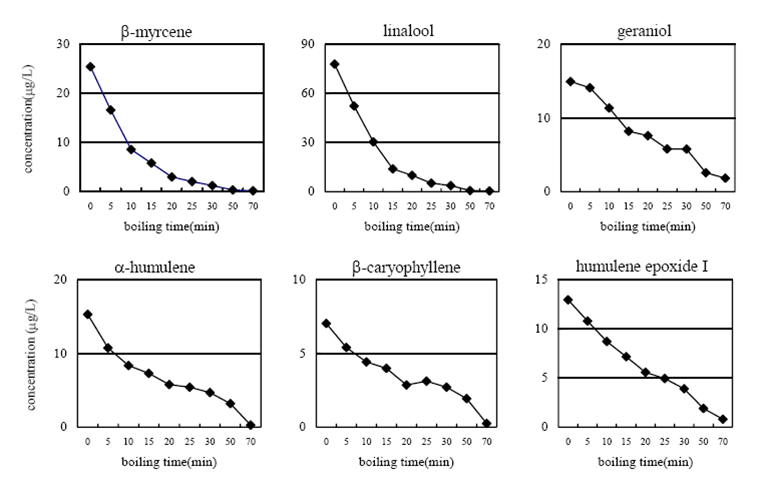This week I take a look at hop aroma oils and some of the best ways to get them into your beer. Fragile hop aroma oils can be very challenging both due to their low vapor/boiling point and low solubility.
What are Hop Aroma Oils?
Aromatic hop oils are oils in the hop cone that make up a tiny portion of the hjop. Typically aroma oils are between 0.5% and 4% of the overall dry hop cone by weight. Aroma oils are different than the alpha and beta acids in the cone which can compose anywhere from 0-22% of the hop by weight.
Where the alpha acids in the hop cone can be isomerized into bittering compounds in the finished beer, aroma oils typically do not contribute any substantial amount of bitterness. Aromatic hop oils instead provide the fragile flowery, herbal, piney, and other aromas.
Aromatic hop oils as a group are made up of many different oils. Some of the major ones include myrcene, linalool, geraniol, alpha-humulene, and caryophyllene.
Why is it so Hard to Infuse Aromatic Hop Oils?
Aromatic hop oils are notoriously hard to get into the beer. In fact many tens of millions of dollars are spent by craft breweries every year to get delicate aroma oils into the beer, as these aromatics are highly desirable in IPAs and other hoppy styles.
The reason aromatic hop oils are so difficult to work with are many. First, aromatic compounds in general are not highly soluble. The reason you smell aromatic compounds is that they quickly come out of solution when exposed to air, so its not surprising that they don’t really like to go into the beer in the first place.
Beyond that, most of the major aromatic oils in hops have boiling temperatures and vaporization points below boiling. So boiling your hops, even for a short time, will vaporize most of the aromatic oils. That’s why many modern brewers have moved to a single boil hop addition for bitterness, and separate whirlpool or dry hop additions done at a lower temperature. The concentration vs boiling time for various aroma oils are shown in the graphic above – as you can see most boil off in 10-15 minutes.
How to Maximize Hop Aromatic Oils
Time and temperature will improve the infusion of aromatic oils into your beer. This closely mirrors the two major methods used to infuse aromatic oils: dry hopping and whirlpool hopping.
Dry hopping which is typically done at room temperature uses an extended period of contact time – typically 24-72 hours – to allow fragile aroma oils to infuse into the finished beer. Whirlpool hopping, by contrast, uses elevated temperature of the unfermented wort to infuse oils.
Each has its advantages and disadvantages. Dry hopping works best for aroma oils with low vaporization points like myrcene as you don’t risk evaporating off a lot of the oil at low temperature. Dry hopping also has the significant advantage of being done after fermentation when there is less risk of losing aromatics by the rapid CO2 bubbling that happens during active fermentation.
However dry hopping takes more time as the beer is much less soluble at room temperature, and if you dry hop too long you can run the risk of introducing lawnmower and vegetal off flavors. This is why many brewers now double or triple dry hop with separate dry hop additions during late fermentation and aging.
Whirlpool hopping is much quicker because the wort is more soluble at an elevated temperature. However you do run the risk of some low vapor point aromatics evaporating. You also have substantial loss of aromatic hop oils during fermentation. In fact a significant portion of the aromatic oils infused in the whirlpool are lost in fermentation by the rapid CO2 bubbles rising through the beer as well as some bio-transformations that take place.
Arguably dry hopping can be more effective overall for preserving aromatic hop oils, but it does take substantially more time than whirlpool hopping, and for commercial breweries time is money. Also the two methods will bring out slightly different hop oil aromatics and flavors which is why most IPA brewers use both.
I will also briefly mention that you can now purchase aromatic hop oil extracts. These are sold either by hop variety or by individual hop oil. The nice thing about these is that you can add them to the finished beer as needed to achieve the effect you want. The downside is that they are fairly expensive to purchase, but they can be an interesting alternative if you want to add a burst of aromatics to a finished beer.
I hope you enjoyed this week’s article from the BeerSmith Home Brewing Blog. Please subscribe for regular weekly delivery, and don’t hesitate to leave a comment or send this article to a friend.
